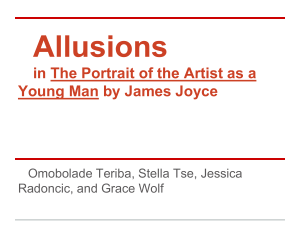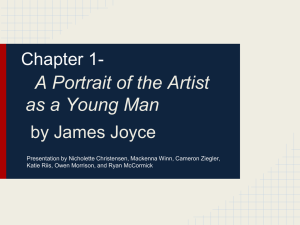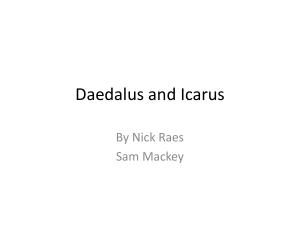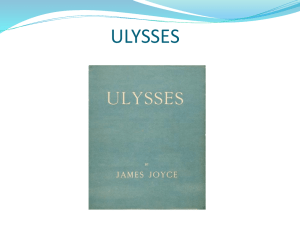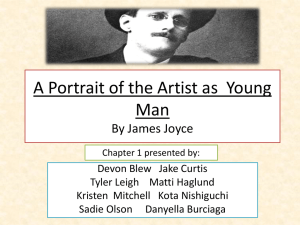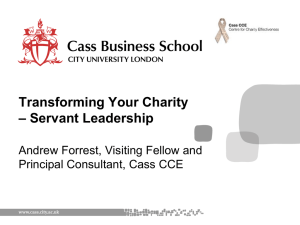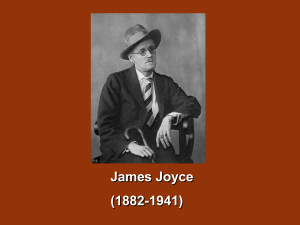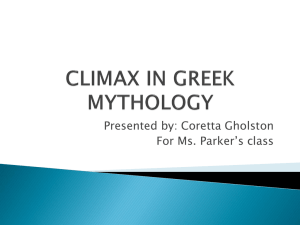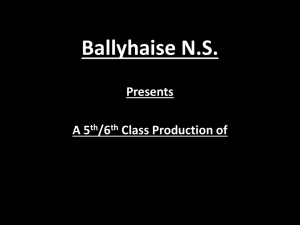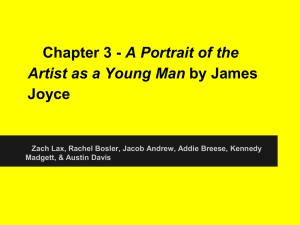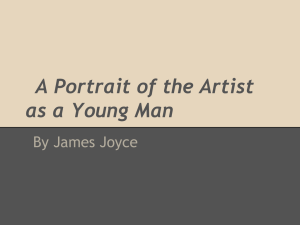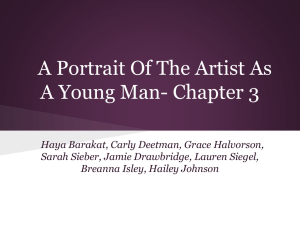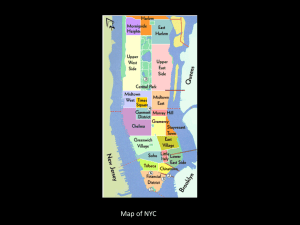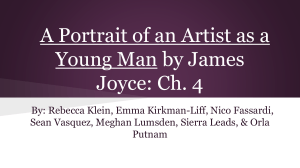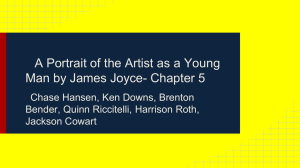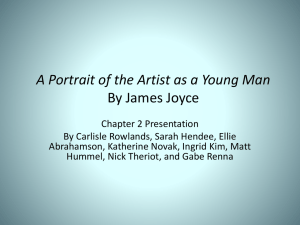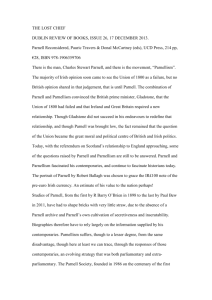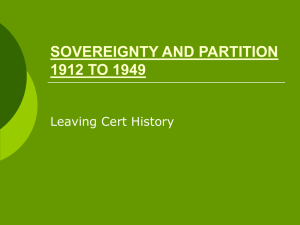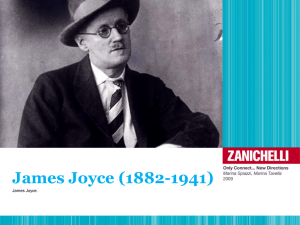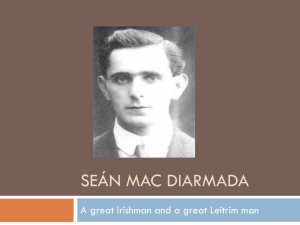A Portrait of the Artist as a Young Man
advertisement
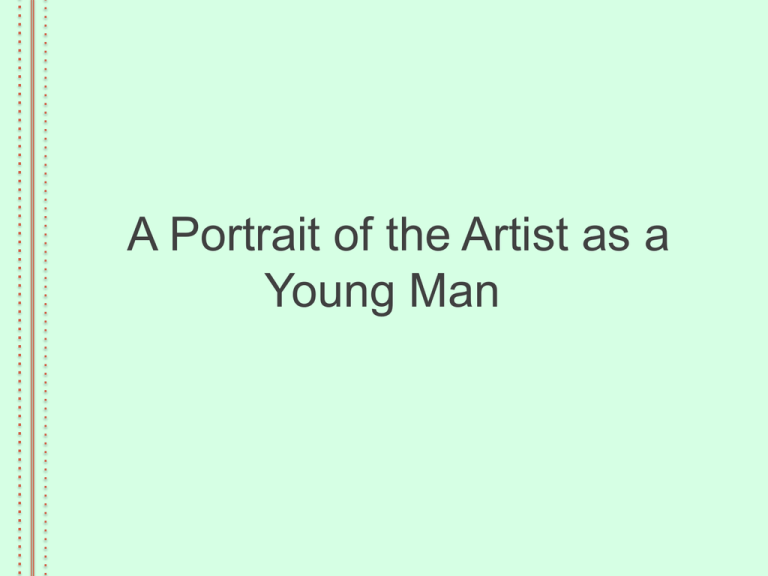
A Portrait of the Artist as a Young Man James Joyce • • • • • • • • Born in 1882 in Dublin, and educated at two Jesuit colleges Clongowes Wood College in Kildare Belvedere College in Dublin After graduating he lived in poverty in Paris writing poetry. Married Nora Barnacle in 1931 By May of 1916, A Portrait of the Artist as a Young Man was published. From 1915-1919 Joyce, his wife Nora and their two children, Georgio and Lucia, lived in Zurich while Joyce worked on the first twelve episodes of Ulysses. After World War I ended, they lived in Paris for the next 20 years. Once World War II began they were forced to exile themselves to Zurich. Joyce died in 1941 in Zurich following surgery on an ulcer. James Joyce was one of the most important influences on the development of the 20th-century novel. Edmund Wilson called him “the great poet of a new phase of human consciousness.” Modernism • • • With the publication of A Portrait of the Artist as a Young Man, James Joyce became recognized as one of the most important modernists shaping the future of literature. Modernism is a style of writing that writers and other artists used with trends such as symbolism, expressionism, imagism, and surrealism. Modernist writers rejected 19th century realism, and remained disengaged from mainstream thought and values, and to present their readers with complex new forms. Important Elements of Joyce’s style • • • • • • When reading Portrait you are taken into the conscious and unconscious thoughts that run endlessly through a character’s mind, and these may include memories of the past suddenly interrupted by fantasies about the future fused with some elements of the present. Stream of Consciousness: the intermingled flow of a character’s thoughts, feelings and perceptions. In Portrait the stream of consciousness was presented through interior monologue: Stephen’s inner thoughts to the reader with no interpretation by the narrator. Epiphany: This term originated in the Christian religion to define a moment when God is clearly revealed. Joyce used it to denote secular revelation in day-to-day life. There are many epiphanies in Portrait, sudden revelations which change Stephen’s life. Motif: an idea, image, or element which is found in many literary works. Leitmotif: is a motif which occurs repeatedly within a single work. Joyce uses a number of recurring motifs in connection with various situations. Pay attention to the following motifs and leitmotifs as you read: eyes and the fear of blindness; water (in all its forms); roses; cows; the colors white, red, yellow and green; birds; flight; cold and warmth. In Portrait Joyce’s style changes with Stephen’s age. When your reading you will recognize Stephen’s progression of age through his Joyce’s sentence structure and Stephen’s thoughts. Point of View • • • Portrait is written in third-person omniscient. Although Joyce is telling us Stephen’s story, we often feel “inside Stephen’s head.” For the most part, we see only what Stephen sees and we know only what he knows. We are just far enough outside of Stephen that we are free to pass judgment on him and wonder what he will do next. Structure • A portrait of the Artist as a Young Man is made up of important episodes in Stephen’s life. – Chapter One: Stephen’s childhood; first hints of disillusionment with his country, church, and family. – Chapter Two: Stephen’s adolescence; sexual awakening; further disillusionment, especially with his father. – Chapter Three: Stephen is 16. His remorse over his sexual activities leads him to try to re-connect with the church. – Chapter Four: The now-pious Stephen, in his late teens, realizes he is living in an inauthentic way and sees his calling not as a priest of the church but as “a priest of the imagination.” – Chapter Five: As a young university student, Stephen develops his artistic theories and realizes he must leave Ireland, which is stifling him. Background Information • A Portrait of the Artist as a Young Man contains many references and allusions to historical events, places, mythology, other works and philosophies of literature, and rituals and tenets of the Catholic church. • • • Irish History Irish Catholicism The Daedalus Myth Irish History • • • • • • Problems between Britain and Ireland began in about 607, when the English crown confiscated land in Ireland – the home of Gaelic Catholics- and sponsored British Protestant settlement there. Rebellions by Irish Catholics led to further losses of property, power, and rights. Irish Catholics suffered from an economic depression. Several Irish peasants where forced to tenant-farm small plots of lands making just enough to be able to feed their families. Several million Irish starved to death due to the potato blight which devastated the potato crops in the 1840’s. Between 1841-1851 many Irish who could afford to emigrate, went to United States and Canada. In the late 1870’s an agricultural depression occurred between the nationalists Charles Stewart Parnell and Michael Davitt, who headed the Land League and campaigned successfully for agricultural reform. • • Parnell led the movement for Home Rule – self-government by an independent Irish parliament. With Catholic leverage in British parliament, Parnell was able to force Britain to accept Home Rule for Ireland. Before the bill was actually passed, however, Parnell’s enemies exposed an adulterous affair Parnell was involved in with Kitty O’Shea, a married woman. (she is referred several times in the book) The Catholic church denounced Parnell, and Parnell’s own supporters deserted him. Parnell died of pneumonia shortly thereafter. Davitt joined the Fenian movement in 1865 and was imprisoned three times by the English for his revolutionary activities. He was especially Influenced by the theories of Henry George. Davitt broke with Parnell over the question of land nationalization, but remained an important irish leader and was instrumental in bringing the Parnell and anti-Parnell factions together in the united Irish League (1898). Irish Catholicism • Like the majority of Irish, James Joyce was raised in the Roman Catholic Church. Like Stephen in A portrait of the Artist as a Young Man, Joyce eventually rejected the church. The novel is interlaced with references to Catholicism, and in order to understand Stephen’s torment and guilt, it is helpful to know some of the basic tenets of the religion he finally abandoned. – Jesuit: Jesuit priests- members of the order of the Society of Jesus- enjoyed considerable prestige within the church and in Irish society because of their reputation for rigid standards in religious, intellectual, and philosophical areas. Stephen’s father wants him to be schooled by “the best,” so Stephen attends Jesuit schools. – Mortal Sin: a serious, willful transgression against the law of God. This sinning can only be forgiven if the sinner is remorseful and promises to repent and not repeat the sin. A person that doesn’t confess his sin soul is deprived of God’s grace and the consequences are Hell. Father Arnell gives a frightening description of the tortures of Hell in Chapter Three. • • • • • • • The Holy Trinity: The principles of the Roman Catholic faith are based on the belief in the existence of the Holy Trinity as one – Father, Son, and Holy Spirit. God is the creator of the universe, and will judge human beings for their sings, with the power to deny them entrance to Heaven. Eucharist (or Communion): Communion is given to Roman Catholics following confession of sins as a sign of God’s grace. Easter Duty: Confession and Communion, required at least once a year, at Easter, the celebration of Christ’s resurrection. Sacrilege: an action or thought that degrades the scared. Stephen discusses sacrilege with Cranly in the last chapter. Seven Deadly Sins: Stephen feels at one point that he is guilt of all of these sins, and even one of them is considered fatal to spiritual progress: Pride, covetousness, lust, anger, gluttony, envy, and sloth. Heresy: Freethinkers were condemned as heretics because their belief varies from that of the church. Stephen becomes a freethinker by the end of the novel. Pergatory The Daedalus Myth • Daedalus is the hero of the Greek myth. According to the myth, Daedalus was a craftsman and inventor who made a hollow wooden cow so that Queen Pasiphae could fulfill her desire to couple with a bull. To contain the half-bull, half-human monster, Daedalus built the Minotaur’s Labyrinth on Crete. When Daedalus later displeased King Minos, the king confined both Daedalus and his son, Icarus, to the labyrinth. Daedalus made wings out of wax and feathers, and he and Icarus flew away. Icarus flew too close to the sun, however, and his wax wings melted. He plunged into the sea and drowned, and Daedalus escaped safely to Sicily. – In addition to sharing his name with the mythical hero, Stephen shares the feelings of being trapped in a maze of his own making. He must fly over the obstacles of church, family, and country to escape over the sea to Europe in order to feel truly free. – Just as the mythical Daedalus was renowned for three cunning achievements – the cow, the labyrinth, and the wings- Stephen tells Cranly he plans to use “silence, exile, and cunning” to defend the free expression of his art. Like Daedalus, he will be a craftsman and inventor, but his materials will be words and imagination. – The Greek “daidolos” is often translated as “cunningly wrought.” In the last line of the novel, the April 27 diary entry, Stephen writes “Old father, old artificer, stand me now and ever in good stead.” Artifice is a synonym for cunning, and Stephen seems to see Daedalus as his spiritual father and muse. Read Poem and Annotate Icaro Volero sopra fiumi, laghi, mari e monti; Oltre le nubi tra cieli infiniti. Senza confini e catene alle mani, Volero oggi e domani. Volero dove il sole riscalda ogni cuore, dove la luna e le stelle vegliano notti senza dolore. Volero nella luce di un Dio infinito, dove la fede ha un solo colore e la gente non muore. Con le ali dell’amore, io posso volare. Read Poem and Annotate… Easier to Understand in English? Icarus I will fly over rivers, lakes, oceans & mountains; Beyond the clouds of the infinite sky. With no barriers or chains on my wrists*; I will fly today and tomorrow. I will fly where the sun warms every heart, where the moon and the stars watch over the night so it passes painlessly. I will fly in the light of an infinite God Where faith has just one colour and people never die. With the wings of love, I can fly.
